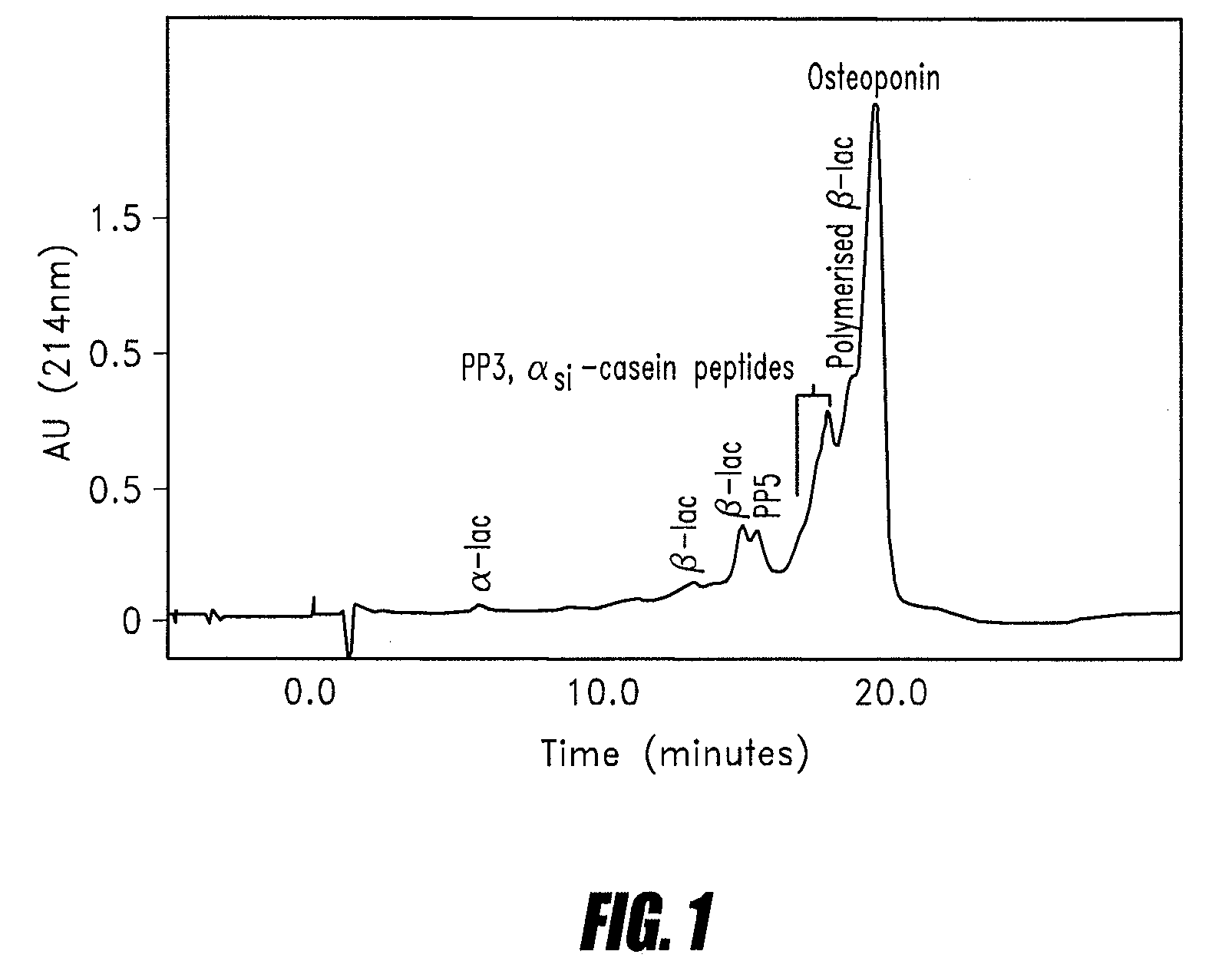Methods of administering bone health compositions derived from milk
a technology of composition and protein, applied in the field of bone health compositions derived from an acidic protein fraction of milk, can solve the problems that the isolation of raw skim is not acceptable commercially, and achieve the effect of reducing net bone loss
- Summary
- Abstract
- Description
- Claims
- Application Information
AI Technical Summary
Benefits of technology
Problems solved by technology
Method used
Image
Examples
example 1
Acidic Protein Fraction Derived from Mineral Acid Whey
[0078]A 20 L solution of mineral acid whey protein concentrate (Alacen 342—available from NZMP, Wellington, New Zealand) at 10% solids and pH 4.5 was passed through a 2 L column of Q-Sepharose BB (Amrad Pharmacia, Australia) at a flow rate of 110 ml / min. The column was washed with 5 L of demineralised water and eluted with a 1.0M solution of sodium chloride (pH 6.0). Protein adsorption and elution was monitored by measuring the absorbance at 280 nm.
[0079]The acidic protein fraction eluted from the column was concentrated approximately 6.25 fold using an Amicon 3K NMCO Spiral ultrafiltration unit (available from Millipore, USA). The concentrated protein retentate was dialysed against water and then freeze dried.
[0080]The dry product (56 g recovered) had a content of 79% protein, less than 0.5% calcium, approximately 1.0% phosphorous and 6.0% sialic acid. The amino acid composition of the eluted protein fraction is shown in Table 1...
example 2
Acidic Protein Fraction Derived from Lactic Acid Whey
[0084]A 20 L solution of lactic acid whey protein concentrate (Alacen 312—available from NZMP, Wellington, New Zealand) at 10% solids and pH 4.5 was passed through a 2 L column of Q-Sepharose BB at a flow rate of 110 ml / min. The column was washed with 5 L of demineralised water and eluted with a 1.0M solution of sodium chloride (pH 6.0). Protein adsorption and elution was monitored by measuring the absorbance at 280 nm.
[0085]The protein eluted from the column was concentrated approximately 6.25 fold using an Amicon 3K NMCO Spiral ultrafiltration unit (available from Millipore, USA). The concentrated protein retentate was dialysed against water and then freeze dried.
[0086]The acidic protein fraction was analysed for whey proteins and proteose peptones by reverse phase HPLC according to the method described by Elgar et al (Journal of Chromatography A, 878 (2000), pp 183-196). An analytical anion exchange Mono Q column HR 5 / 5 (obtain...
example 3
[0088]The product from Example 1 was tested in the bone organ culture model as described by Lowe et al (Journal of Bone and Mineral Research (US), 6(12):1277-1283 (1991)). FIG. 3 shows that the acidic protein fraction had anti-resorptive effects on the cells from the bone organ culture at doses as low as 10 ug / ml. Both lower calcium release and lower thymidine incorporation compared to the controls demonstrate the anti-resorptive effect.
PUM
| Property | Measurement | Unit |
|---|---|---|
| molecular weight | aaaaa | aaaaa |
| molecular weight distribution | aaaaa | aaaaa |
| pH | aaaaa | aaaaa |
Abstract
Description
Claims
Application Information
 Login to View More
Login to View More - R&D
- Intellectual Property
- Life Sciences
- Materials
- Tech Scout
- Unparalleled Data Quality
- Higher Quality Content
- 60% Fewer Hallucinations
Browse by: Latest US Patents, China's latest patents, Technical Efficacy Thesaurus, Application Domain, Technology Topic, Popular Technical Reports.
© 2025 PatSnap. All rights reserved.Legal|Privacy policy|Modern Slavery Act Transparency Statement|Sitemap|About US| Contact US: help@patsnap.com



